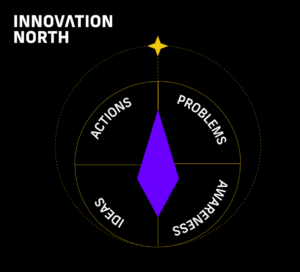Innovation North’s Compass helps businesses innovate for a better future. It’s a practical guide to positive change.
“How do I innovate when everything is changing so fast?”
“I constantly feel like we’re flying an airplane while rebuilding its engine.”
“My CEO says ‘Prove it to me first before I let you try it.’”
These are some of the statements we’ve heard at Innovation North. We’re a community of researchers and practice partners who are co-creating a new approach to innovation that reflects today’s turbulent business environment.
Innovation North is based at Ivey Business School in Canada and led by Tima Bansal (NBS’s former executive director). Collectively, we believe that companies can innovate products, services, and processes that are both profitable and contribute to better societies and the planet. This is known as “sustainable innovation.”
In this article, we describe the tool we co-created, the Innovation North Compass, and how it can help your businesses innovate for a better future.
Why Innovation North Developed the Compass
Our world has become more complex and shaped by systems. But many organizations have kept a narrow view to innovation. Innovators lean towards simple solutions that may create value for their business in the short term, without realizing they may harm themselves and society in the long term. This inward focus is unlikely to prepare business for what is to come.
You’ve likely heard of some of these other innovation approaches, like stage gate, open innovation, and design thinking. There is a time and a place for all of them. But for those companies that want to generate innovations with long-term benefit, the Compass can help. It helps businesses develop the short-term responses needed with crises, while keeping the long-term big picture in mind.
Example: Online Shopping and Product Returns
Here’s an example of how a short-term crisis response can weaken in the longer term.
Many businesses pivoted to online sales during the pandemic, with an e-commerce sales jump from 3.9% in 2019 to a staggering 6.2% in 2022.
Purchasing products online at such an unpredictable time seemed like a necessary innovation. At a time when customers couldn’t get to shops, they could still buy online. And, businesses could still generate revenues and even access new markets.
But shopping online also created unintended consequences, one of which was higher product returns. Approximately 30% of online purchases are returned, compared to less than 9% percent of purchases in brick-and-mortar stores. That means higher costs for the retailer and more waste: most returned product goes directly to landfills.
Businesses often innovate with a narrow view to generate more money. It’s difficult to keep the wider system in mind, especially when many businesses are just trying to keep up with all the short-term pressures they face.
What the Compass Offers
The Compass is a tool co-created by a team of management researchers and corporate innovation leaders across Canada. Here are some of its features:
-
- It is guided by a North Star – a purpose that guides innovators beyond profits.
-
- It recognizes that the innovation process doesn’t always follow a straight line; instead, it may be more circular, integrating new ideas and approaches.
-
- It recognizes the complexities of the world, meaning that innovators should seek several actions to solve several linked problems, rather than one “silver bullet” solution.
-
- It encourages experimentation. Systems are always changing, and actions are ways to learn about them. See what works before making large investments.
How to Use the Innovation North Compass
Here’s our Compass. It solves complex problems by generating novel, actionable ideas that take businesses closer to their overarching purpose.
Innovators start with this purpose, called the North Star, and then move among four spaces: Problems, Awareness, Ideas, and Actions. You’re not alone as you work on this; we have developed a set of Worksheets to guide you every step of the way. (You can either print these out or use them in our favourite collaboration tool – ours is Miro.)

The North Star is the organization’s overarching goal and purpose. It points to a desirable future. That gives the innovation a destination (where are we going and why?) and a direction (how are we getting there?). Innovators capture their organization’s North Star so that they can keep it in focus as they move among different spaces in the Compass.
Let’s move through the different spaces of the Compass.
Problems are gaps between the current situation and the desired future. Working in the Problems space, innovators look at how the problem occurs at different scales or levels in the system. Recognizing those dynamics can lead to rethinking and reframing the problem. You should consider how the problem impacts the company, the industry and supply chain, and the community and planet.
See Problems at Multiple Levels

Awareness means looking at why these problems are happening. Talking to diverse stakeholders can be an especially valuable way to get information. You want to understand what influences the systems surrounding the problem: for example, key actors and activities. This process will show barriers and enablers to change, and often leads to new ways of thinking about the problem.
In the Ideas space, innovators will come up with as many ideas or solutions as they can. These can range from radical and transformational to simple and incremental. There is no silver bullet or one best solution. Innovators group ideas and prioritize them by time, cost, and likelihood of success:

Finally, Actions are efforts taken today and in the near term to address problems so the desirable future becomes within reach. Actions may be new products and services, or symbolic shifts like changes in presentation and communication.
You may need to move through the spaces of the Compass again and again before you have a clear set of actions. For instance, you might be coming up with Ideas when you learn something new about the Problem, which in turn gives you greater Awareness about the system. Think of a Compass needle as it aligns with the Earth’s magnetic field – it may take time to orient your Actions so that they are in line with the organization’s North Star. Be nimble and playful as you move through the different spaces.
Revisiting Product Returns for Sustainable Innovation
This video follows our heroine Clara, a vice president at a retailer who is responsible for tackling the increasing amount of product returns. Watch her journey using the Compass to see what she learns.
Here’s how each space in the Compass applies to Clara’s example:
North Star: Many retailers share similar a similar North Star of improving customers’ lives through the shopping experience. This becomes the purpose for Clara’s innovation.
Problems: Excess product returns are costly and time consuming for the company and often a frustrating process for customers; the waste also has an environmental impact.
Awareness: Conversations with colleagues and stakeholders show Clara that online shopping is driving product returns. Carla maps the return process to understand key pain points (see graphic). She reframes the problem, looking beyond the initial cost.

Ideas: Brainstorming leads to an array of ideas and some priorities. These include premium pricing for people who want the option to return a product and a marketplace app for returned products.
Actions: Clara’s company might test out these ideas to see how effective they are at reducing product returns from online shopping, gradually moving closer towards the business’ North Star.
Apply the Compass to Your Situation
At Innovation North, we’re implementing sustainable innovation in everything from agri-food to to finance to construction. We’re constantly developing new resources for innovators and new partnerships with businesses that are ready to implement sustainable innovation.
If you’re ready to innovate using the Compass, download this set of worksheets that walk you through how to apply it. And reach out to us! We’re eager to know how your company is navigating the complexities of innovation in these turbulent and important times.



Add a Comment
This site uses User Verification plugin to reduce spam. See how your comment data is processed.This site uses User Verification plugin to reduce spam. See how your comment data is processed.